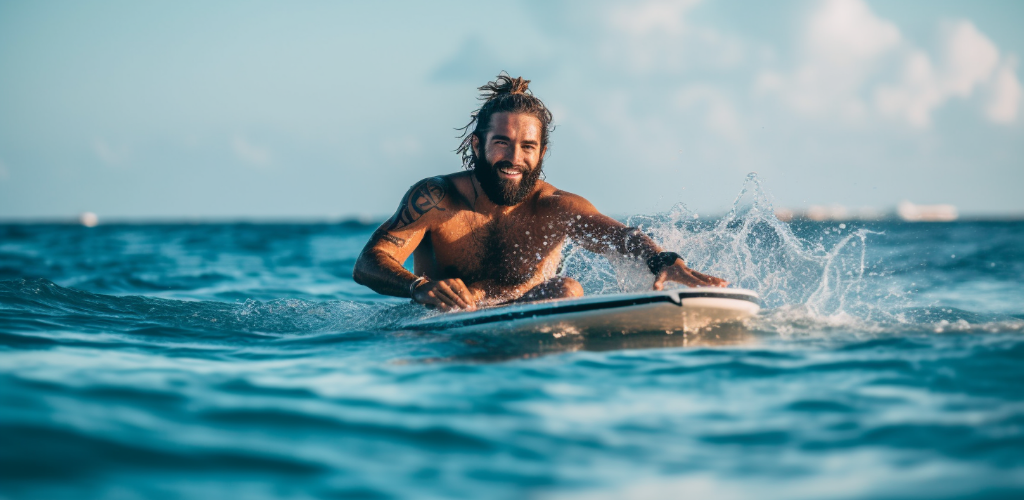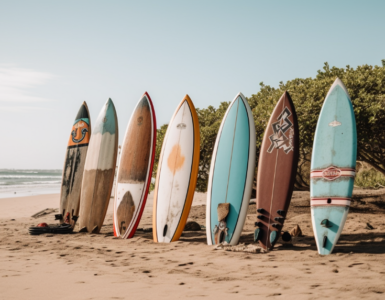Have you ever watched in awe as people ride the waves on a boogie board and wished you could do the same? Well, you’re in the right place! Boogie boarding, also known as bodyboarding, is a popular water sport that gives you the thrill of surfing but with a simpler learning curve. It’s an exhilarating experience that combines fun, fitness, and the joy of being in the water. This post is your guide to learning how to ride a boogie board, making your way from a beginner to a wave-riding pro.
The Basics of Boogie Boarding
So, what exactly is a boogie board? A boogie board, or a bodyboard, is a small, flat, lightweight board that you lie on to ride the waves. It’s made up of a foam core, a slick bottom, and a softer top where you position yourself. You have to get the hang of the basic components of a boogie board before you start riding.
Now, where do you position yourself on the board? The key to a smooth ride is positioning and balance. You should lie flat on the board with your upper body towards the front while your legs float behind. Your arms should grip the sides of the board, and your body should be aligned with the length of the board. Sounds simple, right? It’s all about balance!
Required Equipment for Boogie Boarding
Before you get started, you’re going to need some essential equipment. Here’s a quick rundown of what you’ll need:
- Boogie Board: This is the most obvious one. Ensure it’s the right size for you. If it’s too big or too small, you’ll have a hard time controlling it.
- Leash: This attaches to your wrist or upper arm and prevents your board from getting lost in the waves.
- Swim Fins: These will help you paddle out to the waves and catch them more easily.
- Wetsuit: Depending on the water temperature, you might need a wetsuit. It’ll keep you warm and protect your skin from the sun and rough surf.
- Safety Gear: Don’t forget a good sunscreen and, if you’re in a rocky area, water shoes can be a lifesaver!
Remember, safety should always be your priority when you’re out in the water. So, are you ready to dive into the world of boogie boarding?
Preparing to Ride the Waves
So you’ve got your boogie board and you’re ready to start riding. But where do you begin? The first step is to get into the water. This might seem obvious, but there’s a technique to it.
Start by wading into the water, board in hand. The water should be about waist-deep. You want to be far enough out that you can catch a wave, but not so far that you’re out of your depth. Remember, safety first!
Now, you’re ready to position yourself for a ride. This involves spotting a wave that’s right for you. But how do you know which wave to pick?
Body Positioning on The Board
A good wave for boogie boarding is one that’s just about to break. You want to be positioned so that you’re facing the wave as it comes towards you. This is where body positioning becomes incredibly important.
When you’re on your board, you should be lying flat on your stomach. Your legs and feet should be hanging off the end of the board. This might feel a little uncomfortable at first, but it’s the best way to maintain balance and control over the board.
Proper body alignment is crucial to a successful ride. Your weight should be centered on the board, with your hips and shoulders aligned with the board’s rails. This helps to keep the board steady and prevents it from tipping over.
Paddling Techniques
Now let’s talk about paddling. Paddling is how you propel your board through the water. And there’s a bit of an art to it.
The most common technique is the alternating arm paddle. This involves reaching forward with one arm and pulling through the water, and then doing the same with the other arm. It’s similar to the freestyle stroke in swimming.
Another effective technique is the double arm paddle. This involves reaching forward with both arms at the same time, and then pulling back through the water. This technique can generate more power, helping you to catch a wave more easily.
Remember, the key to effective paddling is to keep your movements smooth and rhythmic. You want to maintain a steady pace that allows you to keep up with the incoming waves.
Mastering the Ride: Step-by-step guide
Ready to hit the water and start riding those waves? Here’s a detailed, step-by-step guide on how to ride a boogie board, from approaching the wave to maneuvering during the ride. Remember, practice makes perfect!
- Approach the Wave: Begin by facing the wave and get into a prone position on the board with your belly down. Your feet should be dangling off the back end of the board.
- Start Paddling: As the wave approaches, start paddling with both hands. The goal is to match your speed with the wave.
- Take the Ride: Once the wave catches you, stop paddling and hold onto the board’s edges. The wave will propel you forward.
- Balance: Maintain your balance by keeping your body centered on the board.
- Maneuver: To steer the board, lean to the side you want to go. To slow down or stop, use your legs as brakes by dipping them into the water.
It’s all about getting a feel for the water and the board. Don’t be discouraged if you wipe out a few times. It’s part of the learning process!
Common Mistakes and How to Avoid Them
As with any new skill, you’re bound to make a few mistakes when you’re first learning to boogie board. Here are some common pitfalls and tips on how to avoid them.
- Incorrect Positioning: Positioning yourself too far forward or backward on the board can lead to poor control and wipeouts. Make sure your body is centered on the board for optimal balance and control.
- Poor Timing: Catching a wave requires timing. If you paddle too early or too late, you might miss the wave or get caught in the break. Practice your timing to get a feel for when to start paddling.
- Not Respecting Other Surfers: Always be aware of other surfers in the water and respect their space. Avoid riding on someone else’s wave or getting in their way.
Remember, everyone was a beginner once. Don’t let these common mistakes discourage you. With time and practice, you’ll be riding waves like a pro in no time!
Advanced Boogie Boarding Tricks
So you’ve mastered the basics of boogie boarding, what’s next? How about adding a little flair to your rides? Advanced boogie boarding tricks can certainly spice up your wave riding experience and impress your beach buddies. But remember, these tricks require practice and control. Don’t rush into them without a solid foundation of the basics.
Some of the tricks you could try include the spin, where you spin your board while riding a wave, or the el rollo, a more advanced trick where you do a complete roll on a wave. Exciting, isn’t it?
Staying Safe While Boogie Boarding
While the thrill of boogie boarding is undeniable, it is essential to prioritize safety. Water sports can be unpredictable, and the ocean is a powerful force. Therefore, it’s crucial to be aware of potential hazards and how to avoid them.
Always keep an eye on the ocean’s conditions, never ride alone, and make sure you’re physically fit to handle the waves. Sounds like a lot? Don’t worry, it’ll all become second nature with time.
| Hazard | Safety Measure |
|---|---|
| Rip Currents | Learn to identify rip currents and never try to swim directly against it. Swim parallel to the shore to escape. |
| Shore Breaks | Be cautious of waves that break directly on the shore, they can cause injuries. Best to avoid riding these. |
| Dehydration | Ensure to hydrate before and after your boogie boarding session. The sun and salt can quickly dehydrate you. |
| Marine Life | Be aware of the marine life in your area. Some creatures can pose a threat, so it’s best to be informed. |
Conclusion and Next Steps
Boogie boarding is an exhilarating and accessible water sport that anyone can enjoy. We’ve covered everything from the basics to some advanced tricks, and most importantly, we’ve highlighted the importance of safety.
What’s the next step? Get out there and start practicing! Remember, the key to mastering boogie boarding is consistency and patience. So, are you ready to ride the waves?




